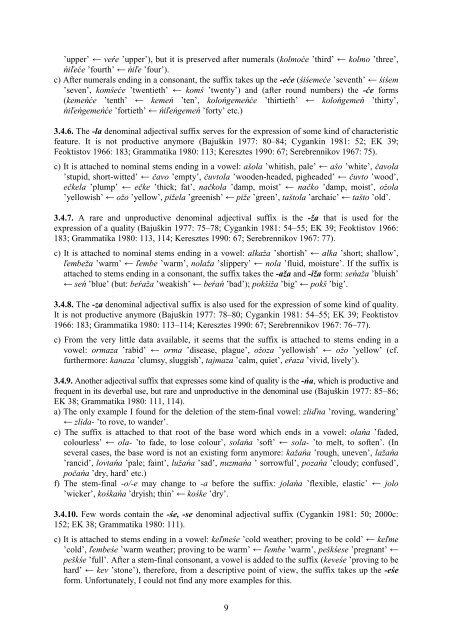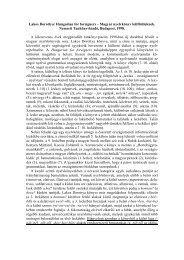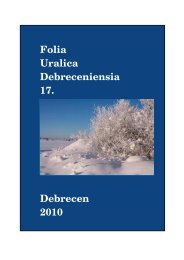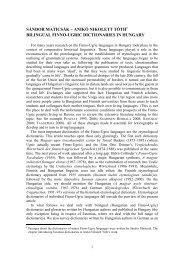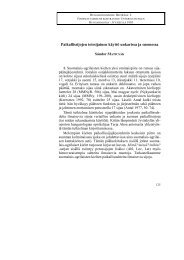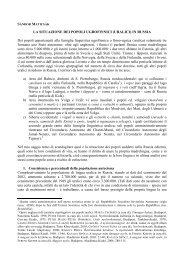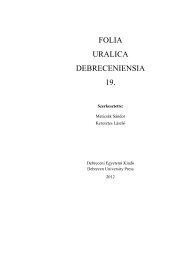Allomorphic variants of Erzya-Mordvin nominal derivational suffixes
Allomorphic variants of Erzya-Mordvin nominal derivational suffixes
Allomorphic variants of Erzya-Mordvin nominal derivational suffixes
You also want an ePaper? Increase the reach of your titles
YUMPU automatically turns print PDFs into web optimized ePapers that Google loves.
’upper’ ← veŕe ’upper’), but it is preserved after numerals (kolmoće ’third’ ← kolmo ’three’,ńiľeće ’fourth’ ← ńiľe ’four’).c) After numerals ending in a consonant, the suffix takes up the -eće (śiśemeće ’seventh’ ← śiśem’seven’, komśeće ’twentieth’ ← komś ’twenty’) and (after round numbers) the -će forms(kemeńće ’tenth’ ← kemeń ’ten’, kolońgemeńće ’thirtieth’ ← kolońgemeń ’thirty’,ńiľeńgemeńće ’fortieth’ ← ńiľeńgemeń ’forty’ etc.)3.4.6. The -la de<strong>nominal</strong> adjectival suffix serves for the expression <strong>of</strong> some kind <strong>of</strong> characteristicfeature. It is not productive anymore (Bajuškin 1977: 80–84; Cygankin 1981: 52; EK 39;Feoktistov 1966: 183; Grammatika 1980: 113; Keresztes 1990: 67; Serebrennikov 1967: 75).c) It is attached to <strong>nominal</strong> stems ending in a vowel: ašola ’whitish, pale’ ← ašo ’white’, čavola’stupid, short-witted’ ← čavo ’empty’, čuvtola ’wooden-headed, pigheaded’ ← čuvto ’wood’,ečkela ’plump’ ← ečke ’thick; fat’, načkola ’damp, moist’ ← načko ’damp, moist’, ožola’yellowish’ ← ožo ’yellow’, pižela ’greenish’ ← piže ’green’, taštola ’archaic’ ← tašto ’old’.3.4.7. A rare and unproductive de<strong>nominal</strong> adjectival suffix is the -ža that is used for theexpression <strong>of</strong> a quality (Bajuškin 1977: 75–78; Cygankin 1981: 54–55; EK 39; Feoktistov 1966:183; Grammatika 1980: 113, 114; Keresztes 1990: 67; Serebrennikov 1967: 77).c) It is attached to <strong>nominal</strong> stems ending in a vowel: alkaža ’shortish’ ← alka ’short; shallow’,ľembeža ’warm’ ← ľembe ’warm’, nolaža ’slippery’ ← nola ’fluid, moisture’. If the suffix isattached to stems ending in a consonant, the suffix takes the -aža and -iža form: seńaža ’bluish’← seń ’blue’ (but: beŕaža ’weakish’ ← beŕań ’bad’); pokšiža ’big’ ← pokš ’big’.3.4.8. The -za de<strong>nominal</strong> adjectival suffix is also used for the expression <strong>of</strong> some kind <strong>of</strong> quality.It is not productive anymore (Bajuškin 1977: 78–80; Cygankin 1981: 54–55; EK 39; Feoktistov1966: 183; Grammatika 1980: 113–114; Keresztes 1990: 67; Serebrennikov 1967: 76–77).c) From the very little data available, it seems that the suffix is attached to stems ending in avowel: ormaza ’rabid’ ← orma ’disease, plague’, ožoza ’yellowish’ ← ožo ’yellow’ (cf.furthermore: kanaza ’clumsy, sluggish’, tajmaza ’calm, quiet’, eŕaza ’vivid, lively’).3.4.9. Another adjectival suffix that expresses some kind <strong>of</strong> quality is the -ńa, which is productive andfrequent in its deverbal use, but rare and unproductive in the de<strong>nominal</strong> use (Bajuškin 1977: 85–86;EK 38; Grammatika 1980: 111, 114).a) The only example I found for the deletion <strong>of</strong> the stem-final vowel: zliďna ’roving, wandering’← zlida- ’to rove, to wander’.c) The suffix is attached to that root <strong>of</strong> the base word which ends in a vowel: olańa ’faded,colourless’ ← ola- ’to fade, to lose colour’, solańa ’s<strong>of</strong>t’ ← sola- ’to melt, to s<strong>of</strong>ten’. (Inseveral cases, the base word is not an existing form anymore: kažańa ’rough, uneven’, lažańa’rancid’, lovtańa ’pale; faint’, lužańa ’sad’, nuzmańa ’ sorrowful’, pozańa ’cloudy; confused’,počańa ’dry, hard’ etc.)f) The stem-final -o/-e may change to -a before the suffix: jolańa ’flexible, elastic’ ← jolo’wicker’, kośkańa ’dryish; thin’ ← kośke ’dry’.3.4.10. Few words contain the -śe, -se de<strong>nominal</strong> adjectival suffix (Cygankin 1981: 50; 2000c:152; EK 38; Grammatika 1980: 111).c) It is attached to stems ending in a vowel: keľmeśe ’cold weather; proving to be cold’ ← keľme’cold’, ľembeśe ’warm weather; proving to be warm’ ← ľembe ’warm’, peškśese ’pregnant’ ←peškśe ’full’. After a stem-final consonant, a vowel is added to the suffix (keveśe ’proving to behard’ ← kev ’stone’), therefore, from a descriptive point <strong>of</strong> view, the suffix takes up the -eśeform. Unfortunately, I could not find any more examples for this.9


